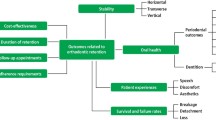Abstract
Data sources The following electronic databases were searched from 1946 to 31 August 2019: Medline, Embase, the Cochrane Oral Health Group's Trials Register, CENTRAL, ClinicalTrials.gov, the National Research Register and Pro-Quest Dissertation Abstracts and Thesis database.
Study selection The following study designs were eligible: randomised controlled trials (RCTs), controlled clinical trials, cohort studies of prospective and retrospective design, and cross-sectional studies that reported periodontal measurements on patients who received fixed retention after orthodontic therapy. Studies irrespective of their language were selected by two reviewers independently.
Data extraction and synthesis Data extraction from the selected studies and risk of bias assessments were performed by two reviewers independently. Specific risk of bias tools were used according to the pertinent research designs of the included studies. Criteria for conducting a meta-analysis were not met and a qualitative synthesis was conducted.
Results Twenty-nine studies fulfilled the eligibility criteria; that is, 11 RCTs, four prospective cohort studies, one retrospective cohort study and 13 cross-sectional studies. The quality of the evidence was low for most of the studies included in this review. Contrary to the general consensus, two RCTs, one prospective cohort study and two cross-sectional studies identified poorer periodontal health in patients with fixed orthodontic retainers.
Conclusions The authors of this systematic review concluded that fixed orthodontic retainers in the majority of the 29 included studies seemed to be a method of retention that is rather compatible with periodontal health, or at least not related to severe detrimental consequences for the periodontium. No recommendations on the best type of fixed retainer to use could be given. High-quality evidence from long-term studies is necessary to provide definitive conclusions on the relationship between fixed retainers and periodontal health.
This is a preview of subscription content, access via your institution
Access options
Subscribe to this journal
Receive 4 print issues and online access
$259.00 per year
only $64.75 per issue
Buy this article
- Purchase on Springer Link
- Instant access to full article PDF
Prices may be subject to local taxes which are calculated during checkout
Similar content being viewed by others
References
Arn M L, Dritsas K, Pandis N, Kloukos D. The effects of fixed orthodontic retainers on periodontal health: A systematic review. Am J Orthod Dentofacial Orthop 2020; 157: 156-164.
Liberati A, Altman D G, Tetzlaff J et al. The PRISMA statement for reporting systematic reviews and meta-analyses of studies that evaluate health care interventions: explanation and elaboration. PLoS Med 2009; 339: DOI: 10.1136/bmj.b2700.
Moher D, Liberati A, Tetzlaff J, Altman DG, PRISMA Group. Preferred reporting items for systematic reviews and meta-analyses: the PRISMA statement. PLoS Med 2009; 6: DOI: 10.1371/journal.pmed.1000097.
Stevens A, Garritty C, Hersi M, Moher D. Developing PRISMA-RR, a reporting guideline for rapid reviews of primary studies (Protocol). Available at http://www.equator-network.org/wp-content/uploads/2018/02/PRISMA-RR-protocol.pdf (accessed March 2020).
Shea B J, Reeves B C, Wells G et al. AMSTAR 2: a critical appraisal tool for systematic reviews that include randomised or non randomised studies of healthcare interventions, or both. BMJ 2017; 358: DOI:10.1136/bmj.j4008.
University of Bristol. Risk of bias in systematic reviews (ROBIS). ROBIS tool and the ROBIS guidance document. Available at http://www.bristol.ac.uk/social-community-medicine/projects/robis/ (accessed February 2020).
Whiting P, Savović J, Higgins J P et al. ROBIS: A new tool to assess risk of bias in systematic reviews was developed. J Clin Epidemiol 2016; 69: 225-234.
PROSPERO: Centre for Reviews and Dissemination. University of York UK. Available at http://www.crd.york.ac.uk/PROSPERO/ (accessed February 2020).
Kirkham J J, Altman D G, Williamson P R. Bias due to changes in specified outcomes during the systematic review process. PLoS One 2010; 5: DOI: 10.1371/journal.pone.0009810.
Page M J, McKenzie J E, Kirkham J et al. Bias due to selective inclusion and reporting of outcomes and analyses in systematic reviews of randomised trials of healthcare interventions. Cochrane Database Syst Rev 2014; DOI: 10.1371/journal.pone.0009810.
Stewart L, Moher D, Shekelle P. Why prospective registration of systematic reviews makes sense. Syst Rev 2012; 1: 7.
Cooke A, Smith D, Booth A. Beyond PICO: the SPIDER tool for qualitative evidence synthesis. Qual Health Res 2012; 22: 1435-1443.
Golder S, Loke Y K, Wright K, Norman G. Reporting of adverse events in published and unpublished studies of health care interventions: a systematic review. PLoS Med 2016; 13: DOI: 10.1371/journal.pmed.1002127.
Schroll J B, Penninga E I, Gøtzsche P C. Assessment of Adverse Events in Protocols, Clinical Study Reports, and Published Papers of Trials of Orlistat: A Document Analysis. PLoS Med 2016; 13: DOI: 10.1371/journal.pmed.1002101.
Author information
Authors and Affiliations
Corresponding author
Rights and permissions
About this article
Cite this article
Steegmans, P., Meursinge Reynders, R. Fixed orthodontic retainers and periodontal health. Evid Based Dent 21, 146–149 (2020). https://doi.org/10.1038/s41432-020-0144-0
Published:
Issue Date:
DOI: https://doi.org/10.1038/s41432-020-0144-0



